Manual and Automatic Measurements of Sunshine Duration in Cassubian Lakeland (Northern Poland)
Abstract
1. Introduction
2. Materials and Methods
3. Results
3.1. Comparison of Measurement Results of Actual Sunshine Duration Measured Using a Campbell–Stokes Sunshine Recorder and a CSD3 Sensor
3.2. Reconstruction of Sunshine Duration in Borucino for the Period 1991–2020
3.3. Comparison of Measurement Results of Actual Sunshine Duration Measured Using a Campbell–Stokes Sunshine Recorder and a CSD3 Sensor under Various Cloud Cover
- CSDi: the ith sunshine duration recorded with the CSD sensor;
- CSi: the ith sunshine duration recorded with the Campbell–Stokes recorder;
- n: number of cases.
4. Discussion and Conclusions
Author Contributions
Funding
Institutional Review Board Statement
Informed Consent Statement
Data Availability Statement
Acknowledgments
Conflicts of Interest
References
- World Meteorological Organization. Instruments and observing methods report 16. In Comparison of Pyranometers and Electronic Sunshine Duration Recorders of RA VI, Budapest, July–December 1984; WMO/TD No.146; WMO: Geneva, Switzerland, 1986; pp. 1–4. Available online: https://library.wmo.int/index.php?lvl=notice_display&id=15513#.Y5jG54SZOMq (accessed on 30 November 2022).
- Ikeda, H.; Aoshima, T.; Miyake, Y. Development of a new sunshine-duration meter. J. Meteorol. Soc. Jpn. Ser. II 1986, 64, 987–992. [Google Scholar] [CrossRef]
- World Meteorological Organization. International Meteorological Vocabulary; WMO/OMM/BMO-No.182; WMO: Geneva, Switzerland, 1992; p. 296. Available online: https://library.wmo.int/?lvl=notice_display&id=220#.Y5jQJoSZOMo (accessed on 30 November 2022).
- Sanchez-Romero, A.; Gonzalez, J.A.; Calbó, J.; Sánchez-Lorenzo, A. Using digital image processing to characterize the Campbell-Stokes sunshine recorder and to derive high-temporal resolution direct solar irradiance. Atmos. Meas. Tech. 2015, 8, 183–194. [Google Scholar] [CrossRef]
- World Meteorological Organization. Guide to Instruments and Methods of Observation. Volume I Measurements of Meteorological Variables; WMO-No 8; WMO: Geneva, Switzerland, 2021; pp. 308–323. Available online: https://library.wmo.int/index.php?id=12407&lvl=notice_display#.Y5js8YSZOMo (accessed on 30 November 2022).
- Wang, Y.; Zhang, G.; Sun, G.; Liu, S.; Xu, D.; Yang, S.; Wu, L. A review on sunshine recorders: Evolution of operation principle and construction. Measurement 2021, 186, 110138. [Google Scholar] [CrossRef]
- Kuchcik, M.; Błażejczyk, K.; Szmyd, J.; Milewski, P.; Błażejczyk, A.; Baranowski, J. Potencjał Leczniczy Klimatu Polski (The Therapeutic Potential of Polish Climate); Wydawnictwo Akademickie SEDNO; Instytut Geografii i Przestrzennego Zagospodarowania PAN: Warsaw, Poland, 2013; pp. 1–272. Available online: https://www.rcin.org.pl/igipz/dlibra/publication/edition/56052?id=56052 (accessed on 5 December 2022). (In Polish)
- Szatten, D.; Więcław, M. Solar climate features taking into account the morphometric conditions of the area and the possibility of using them in heliotherapy on the example of the Cieplice and Kołobrzeg health resorts (Poland). Atmosphere 2021, 12, 383. [Google Scholar] [CrossRef]
- Mieczkowski, Z. The tourism climatic index: A method of evaluating world climates for tourism. Can. Geogr. 1985, 29, 220–233. [Google Scholar] [CrossRef]
- de Freitas, C.R.; Scott, D.; McBoyle, G. A second-generation climate index for tourism (CIT): Specification and verification. Int. J. Biometeorol. 2008, 52, 399–407. [Google Scholar] [CrossRef]
- Bae, J.; Nam, S. An analysis of the effect of climate indicators on tourism demand: A case study of Jeju Island. J. Policy Res. Tour. Leis. Events 2020, 12, 185–196. [Google Scholar] [CrossRef]
- Min, C.-Y.; Yoo, D.-M.; Choi, H.-G. Associations between physical activity, sunshine duration and osteoporosis according to obesity and other lifestyle factors: A nested case–control study. Int. J. Environ. Res. Public Health 2021, 18, 4437. [Google Scholar] [CrossRef]
- Thangariyal, S.; Rastogi, A.; Tomar, A.; Bhadoria, A.S.; Baweja, S. Impact of temperature and sunshine duration on daily new cases and death due to COVID-19. J. Fam. Med. Prim. Care 2020, 9, 6091–6101. [Google Scholar]
- Ji, Y.; Chen, C.; Xu, G.; Song, J.; Su, H.; Wang, H. Effects of sunshine duration on daily outpatient visits for depression in Suzhou, Anhui Province, China. Environ. Sci. Pollut. Res. 2023, 30, 2075–2085. [Google Scholar] [CrossRef] [PubMed]
- Nishio, Z.; Uchikawa, O.; Hideshima, Y.; Nishioka, H.; Mihara, M.; Nakamura, K.; Matsunaka, H.; Yamaguchi, K. Influence of precipitations and sunshine hours on yield of paddy field grown wheat (Triticum aestivum L.) in Northern Kyushu, Japan. Plant Prod. Sci. 2019, 22, 479–489. [Google Scholar] [CrossRef]
- Guo, C.; Dai, H.; Liu, X.; Wu, Y.; Liu, X.; Liu, Y. Impacts of climate change mitigation on agriculture water use: A provincial analysis in China. Geogr. Sustain. 2020, 1, 189–199. [Google Scholar] [CrossRef]
- Song, L.; Jin, J. Effects of Sunshine hours and daily maximum temperature declines and cultivar replacements on maize growth and yields. Agronomy 2020, 10, 1862. [Google Scholar] [CrossRef]
- Bartoszek, K.; Matuszko, D.; Węglarczyk, S. Trends in sunshine duration in Poland (1971–2018). Int. J. Climatol. 2021, 41, 73–91. [Google Scholar] [CrossRef]
- Marsz, A.A.; Styszyńska, A. Zmiany usłonecznienia rzeczywistego w Polsce i ich przyczyny (1966–2018), Changes in sunshine duration in Poland and their causes (1966–2018). Pol. Pr. Geogr. 2021, 165, 23–52. [Google Scholar] [CrossRef]
- Baumgartner, D.J.; Pötzi, W.; Freislich, H.; Strutzmann, H.; Veronig, A.M.; Foelshche, U.; Rieder, H.E. A comparison of long-term parallel measurements of sunshine duration obtained with a Campbell-Stokes sunshine recorder and two automated sunshine sensors. Theor. Appl. Climatol. 2018, 133, 263–275. [Google Scholar] [CrossRef]
- Pallé, E.; Butler, C.J. Comparison of sunshine records and synoptic cloud observations: A case study for Ireland. Phys. Chem. Earth 2002, 27, 405–414. [Google Scholar] [CrossRef]
- Stanhill, G. Through a glass brightly: Some new light on the Campbell–Stokes sunshine recorder. Weather 2003, 58, 3–11. [Google Scholar] [CrossRef]
- Sanchez-Lorenzo, A.; Calbó, J.; Wild, M.; Azorin-Molina, C.; Sanchez-Romero, A. New insights into the history of the Campbell-Stokes sunshine recorder. Weather 2013, 68, 327–331. [Google Scholar] [CrossRef]
- Zhou, H.; Quan, W.; Wang, Z.; Li, X.; Li, Y.; Zhao, H. Comparison of sunshine duration measurements between a Jordan sunshine recorder and three automatic sensors at Shangdianzi GAW station. J. Meteorol. Res. 2021, 35, 716–728. [Google Scholar] [CrossRef]
- World Meteorological Organization. Abridged Final Report of the Third Session of the Commission for Instruments and Methods of Observation, New Delhi 1962; WMO-No. 116, R.P. 48; WMO: Geneva, Switzerland, 1962; pp. 25–77. Available online: https://library.wmo.int/index.php?lvl=notice_display&id=9847#.Y5j5kISZOMp (accessed on 30 November 2022).
- Matuszko, D. A comparison of sunshine duration records from the Campbell-Stokes sunshine recorder and CSD3 sunshine duration sensor. Theor. Appl. Climatol. 2015, 119, 401–406. [Google Scholar] [CrossRef]
- Hannak, L.; Friedrich, K.; Imbery, F.; Kaspar, F. Comparison of manual and automatic daily sunshine duration measurements at German climate reference stations. Adv. Sci. Res. 2019, 16, 175–183. [Google Scholar] [CrossRef]
- Kipp & Zonen. CHP1 Pyrheliometer Instruction Manual; Ver. 0811; Kipp & Zonen B.V.: Delft, The Netherlands, 2008; pp. 1–23. Available online: https://www.kippzonen.com/Download/202/CHP-1-Pyrheliometer-Manual (accessed on 7 January 2023).
- Kipp & Zonen. Instruction Manual for CMP Series Pyranometer; Doc. No. V1610; Kipp & Zonen B.V.: Delft, The Netherlands, 2016; pp. 1–46. Available online: https://www.kippzonen.com/Download/72/Manual-Pyranometers-CMP-series (accessed on 7 January 2023).
- Kipp & Zonen. CSD1 Sunshine Duration Meter Instruction Manual; Ver. 0804; Kipp & Zonen B.V.: Delft, The Netherlands, 2003; pp. 1–41. Available online: https://www.kippzonen.com/Download/90/CSD-1-Manual (accessed on 7 January 2023).
- Kipp & Zonen. CSD3 Sunshine Duration Sensor Instruction Sheet; Kipp & Zonen B.V.: Delft, The Netherlands, 2018; p. 1. Available online: https://www.kippzonen.com/Product/35/CSD3-Sunshine-Duration-Sensor#.Y73pI4SZOMo (accessed on 7 January 2023).
- Kipp & Zonen. The Kipp & Zonnen Products Catalogue; Kipp & Zonen B.V.: Delft, The Netherlands, 2016; pp. 1–92. Available online: https://www.kippzonen.com/Download/576/Kipp-Zonen-Product-Catalogue (accessed on 7 January 2023).
- Delta-T. SPN1 Sunshine Pyranometer; User Manual Ver. 4.2; Delta-T Devices Ltd.: Cambridge, UK, 2019; pp. 1–64. Available online: https://delta-t.co.uk/product/spn1/ (accessed on 7 January 2023).
- Kejna, M.; Uscka-Kowalkowska, J. Porównanie wyników rejestracji usłonecznienia heliografem Campbella-Stokesa i czujnikiem świecenia Słońca DSU12 w Koniczynce k. Torunia w latach 2006–2010 (Comparison of the results of sunshine duration recording by a Campbell-Stokes heliograph and a sunshine duration DSU12 at Koniczynka near Toruń in the years 2006–2010; in Polish). Prz. Geof. 2012, 57, 11–20. Available online: http://ptgeof.imgw.pl/zalaczniki/download.php?plik=PG%201%202012%20Kejna.pdf (accessed on 30 November 2022).
- Kroneis GmbH. Kroneis Solar 111 Sunshine Duration Sensor Product Information; Kroneis GmbH: Vienna, Austria, 2018; p. 1. Available online: https://www.kroneis.at/meteorologische-sensoren/strahlung (accessed on 7 January 2023).
- Kerr, A.; Tabony, R. Comparison of sunshine recorded by Campbell–Stokes and automatic sensors. Weather 2004, 59, 90–99. [Google Scholar] [CrossRef]
- Perry, M. Updated Comparison of Sunshine Duration Recorded by Campbell-Stokes and Automatic Sensors; National Climate Information Centre Climate Memorandum, 27; Met Office: Exeter, UK, 2011; pp. 1–20. Available online: https://library.metoffice.gov.uk/Portal/Default/en-GB/RecordView/Index/252478 (accessed on 5 December 2022).
- Legg, T. Comparison of daily sunshine duration recorded by Campbell–Stokes and Kipp and Zonen sensors. Weather 2014, 69, 264–267. [Google Scholar] [CrossRef]
- Kejna, M.; Uscka-Kowalkowska, J. Porównanie wyników pomiarów meteorologicznych w Stacji ZMŚP w Koniczynce (Pojezierze Chełmińskie) wykonanych metodą tradycyjną i automatyczną w roku hydrologicznym 2002 (A comparison of traditional and automatic measurements at the Koniczynka monitoring station (Chełmińskie Lakeland, Northern Poland), during the hydrological year 2002. Ann. Univ. Mariae Curie-Skłodowska Sec. B 2006, 61, 208–217. (In Polish) [Google Scholar]
- Pokorný, J.; Vaníček, K. Automatizace měření slunečního svitu na stanicích Českého hydrometeorologického ústavupomocí elektronických slunoměrů (Automation of measurements of sunshine duration at stations of the Czech Hydrometeorological Institute by electronic sensors. Meteorol. Zprávy 2007, 60, 106–116. Available online: http://www.cmes.cz/sites/default/files/MZ_2007_4_slunom%C4%9Bry.pdf (accessed on 5 December 2022). (In Czech).
- Matuszko, D. Porównanie wartości usłonecznienia mierzonego heliografem Campbella-Stokesa i czujnikiem elektronicznym CSD3 (Comparison of sunshine duration measured by a Campbell-Stokes heliograph and a CSD3 electronic sensor. Prz. Geofiz. 2012, 57, 4–10. Available online: http://ptgeof.imgw.pl/zalaczniki/download.php?plik=PG%201%202012%20Matuszko.pdf (accessed on 5 December 2022). (In Polish).
- Urban, G.; Zając, I. Comparison of sunshine duration measurements from Campbell-Stokes sunshine recorder and CSD1 sensor. Theor. Appl. Climatol. 2017, 129, 77–87. [Google Scholar] [CrossRef]
- Matuszko, D. Influence of cloudiness on sunshine duration. Int. J. Climatol. 2012, 32, 1527–1536. [Google Scholar] [CrossRef]
- Kothe, S.; Pfeifroth, U.; Cremer, R.; Trentmann, J.; Hollmann, R. A satellite-based sunshine duration climate data record for Europe and Africa. Remote Sens. 2017, 9, 429. [Google Scholar] [CrossRef]
- Bartoszek, K. Actual sunshine duration in Poland—Comparison of satellite and ground-based measurements. Prz. Geof. 2018, 63, 329–338. Available online: http://ptgeof.imgw.pl/?strona=5,20,3 (accessed on 5 December 2022).
- Matuszko, D.; Bartoszek, K.; Soroka, J.; Węglarczyk, K. Sunshine duration in Poland from ground-and satellite-based data. Int. J. Clim. 2020, 40, 4259–4271. [Google Scholar] [CrossRef]
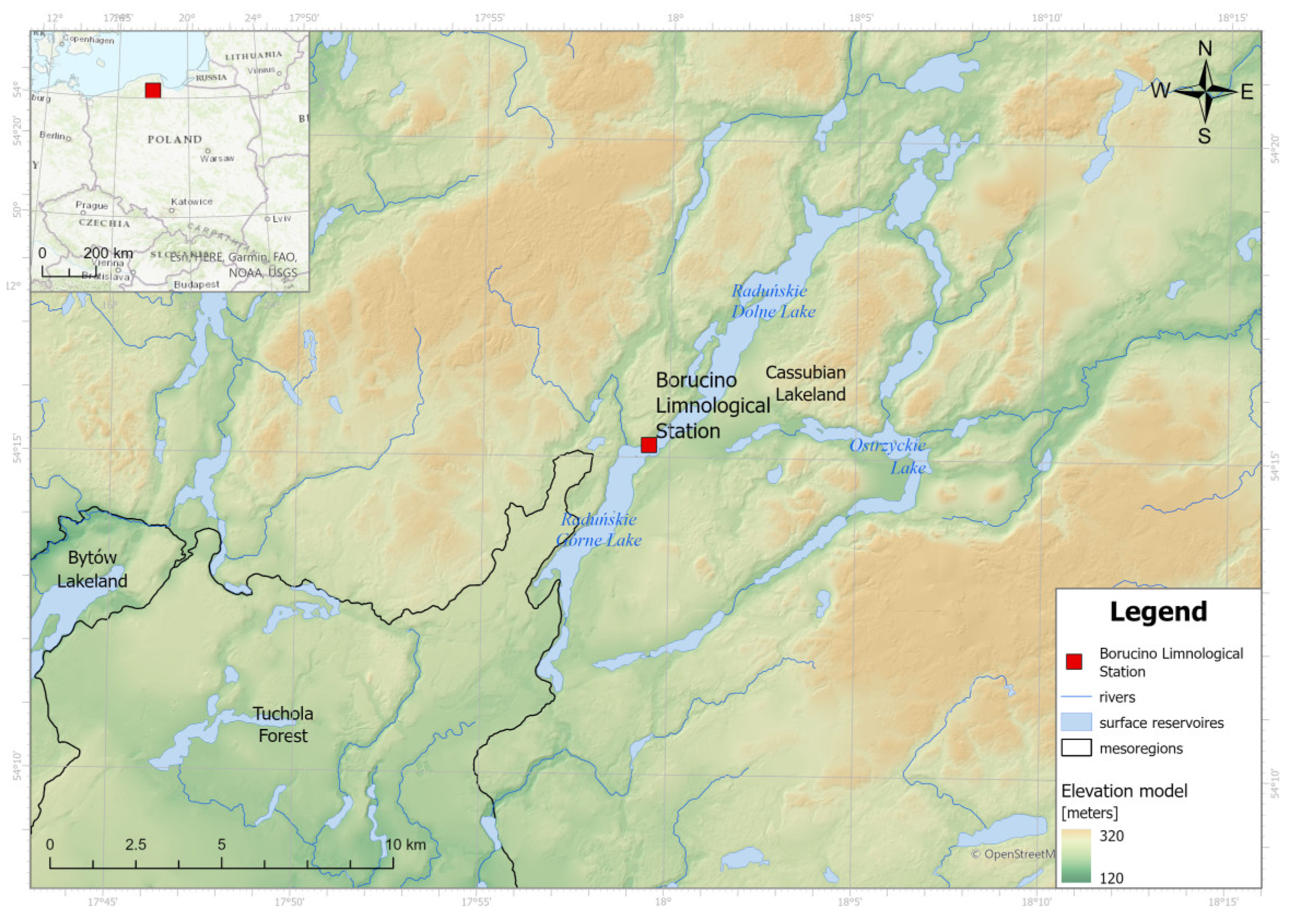


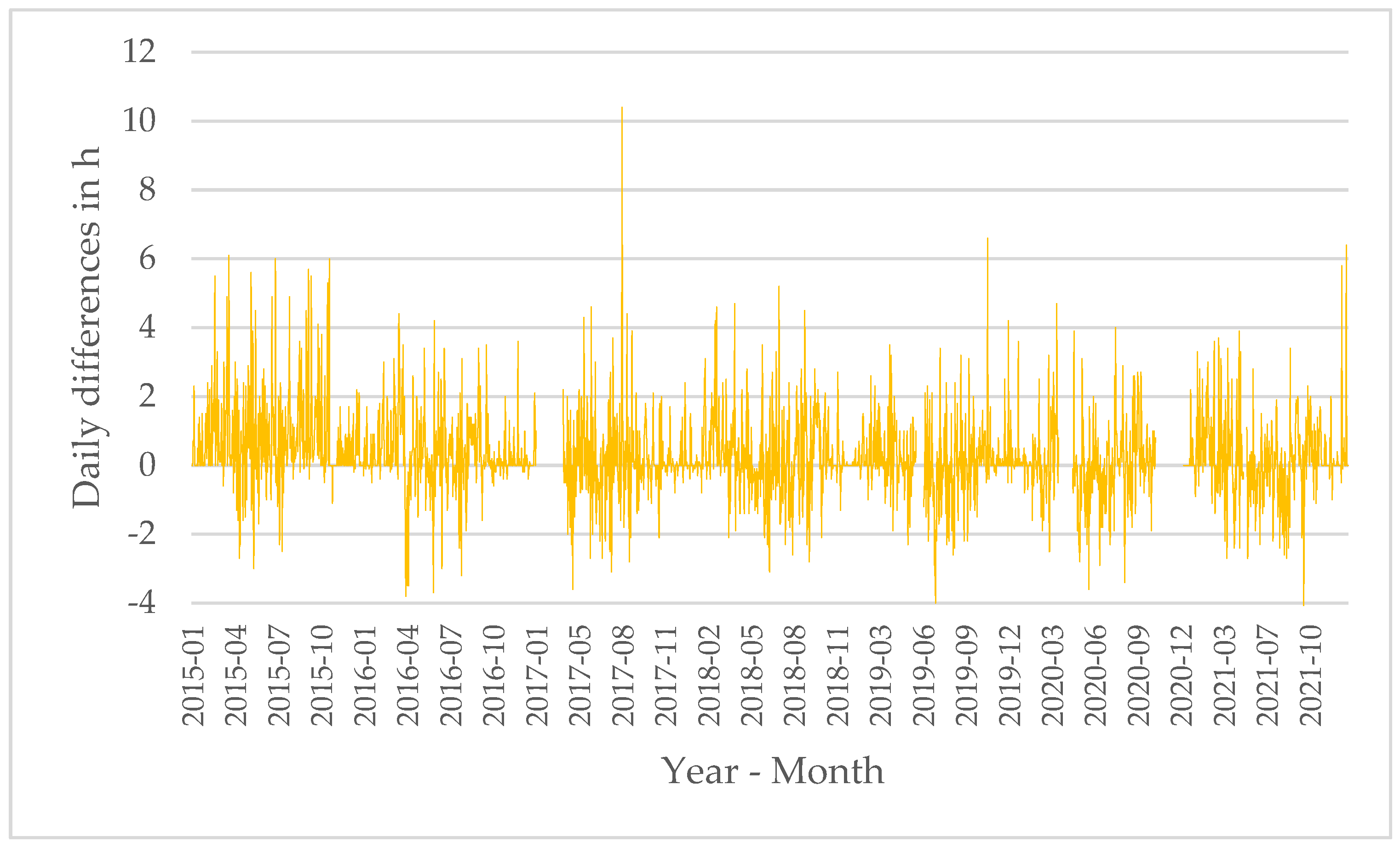
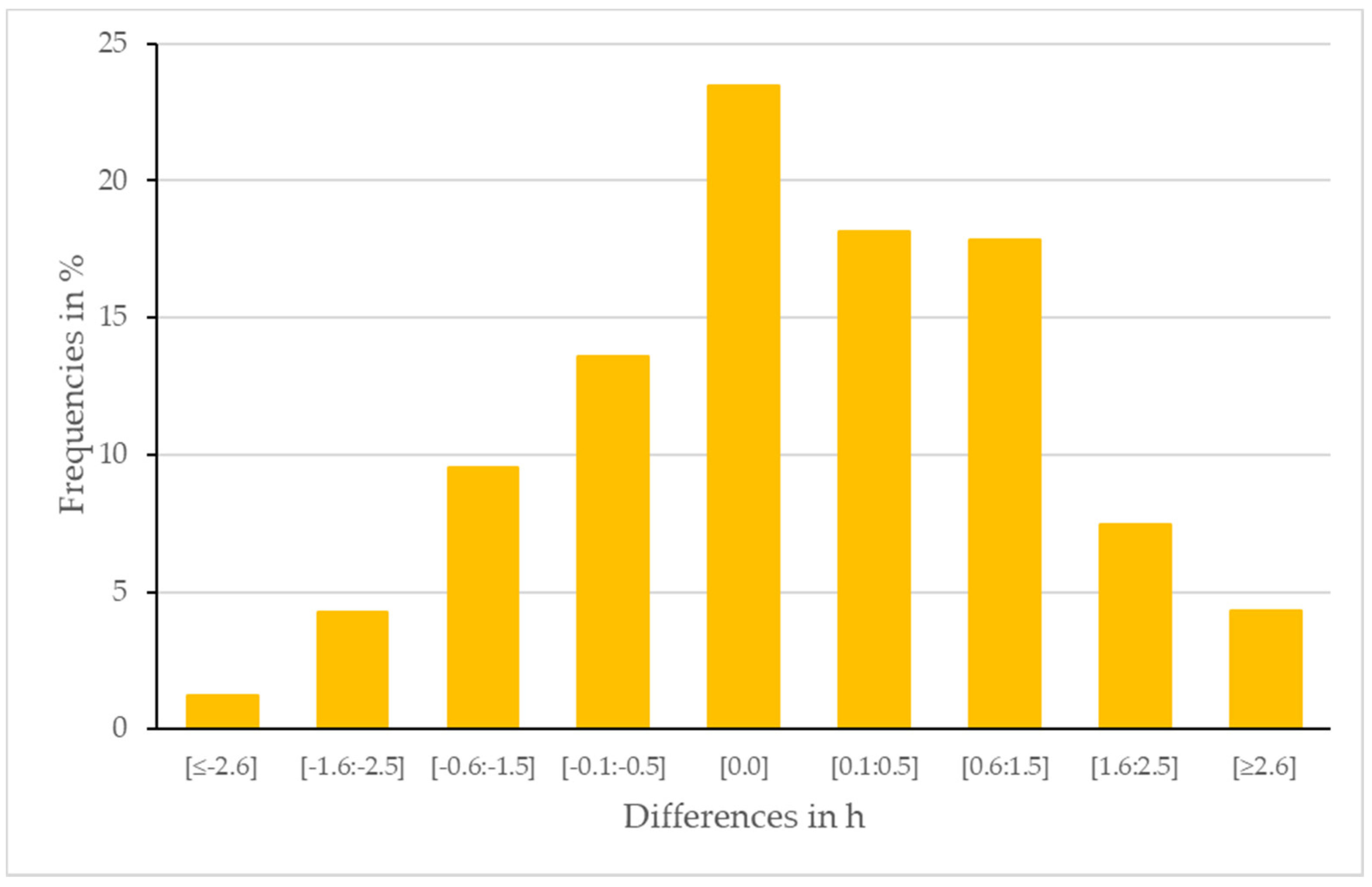
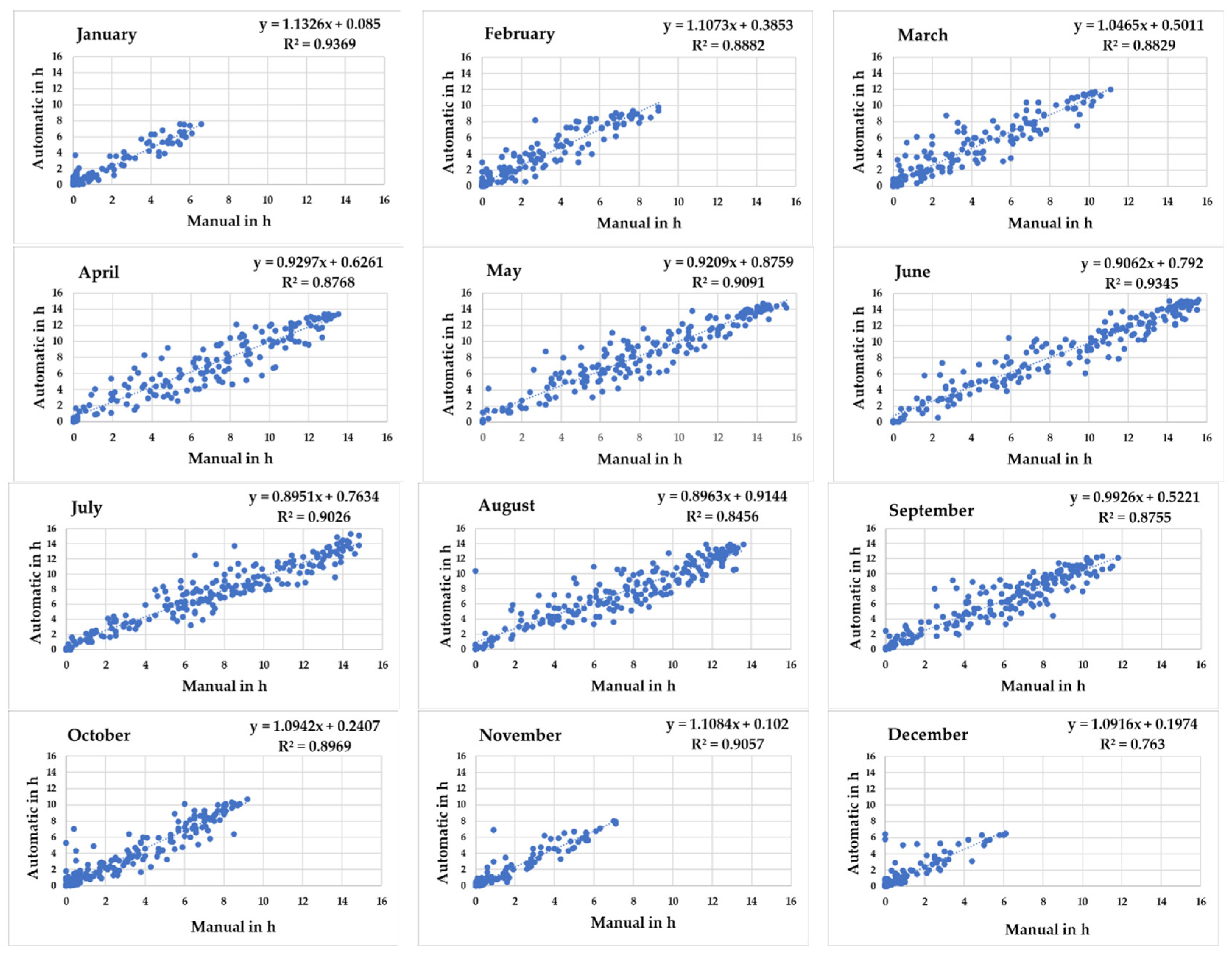
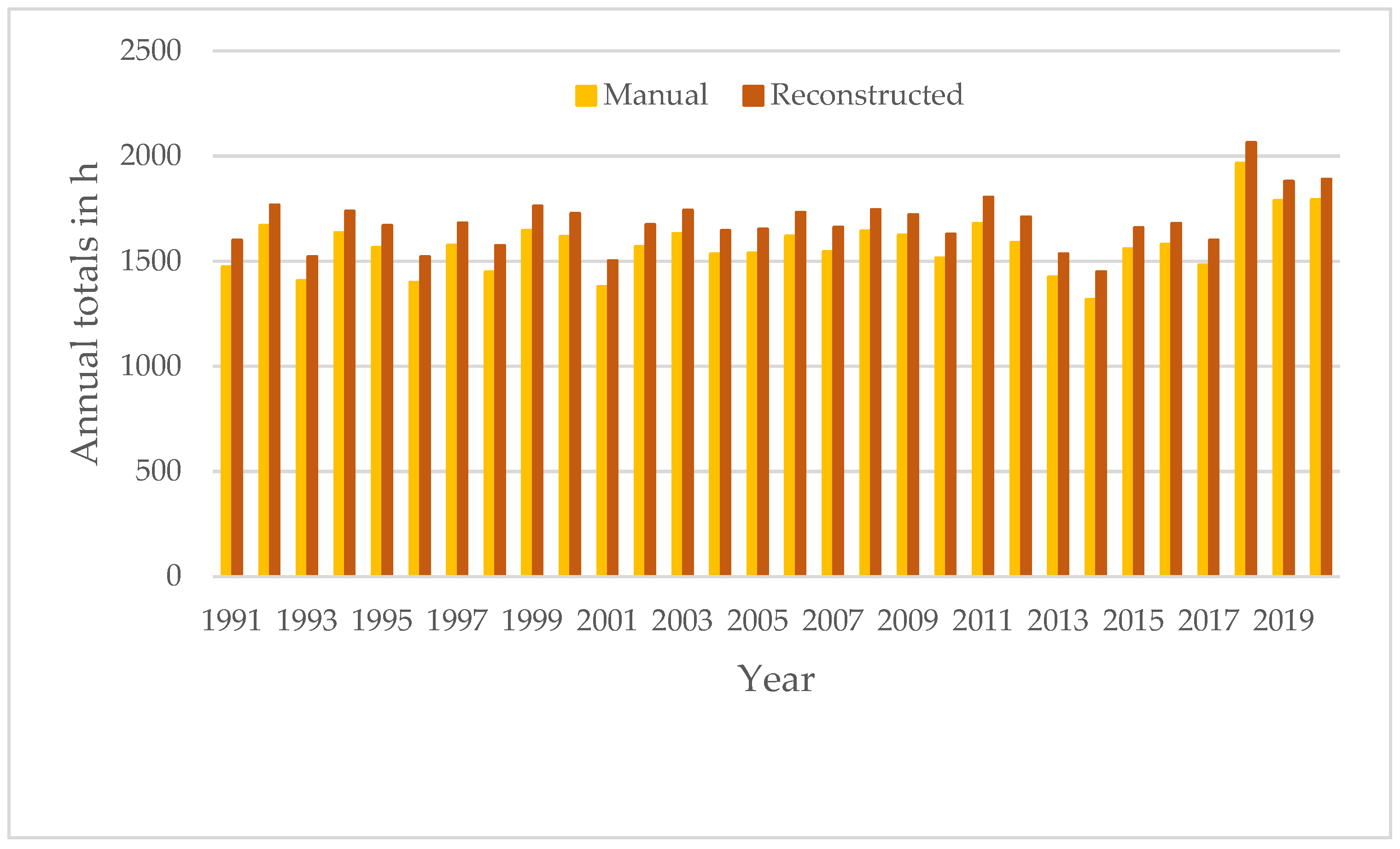

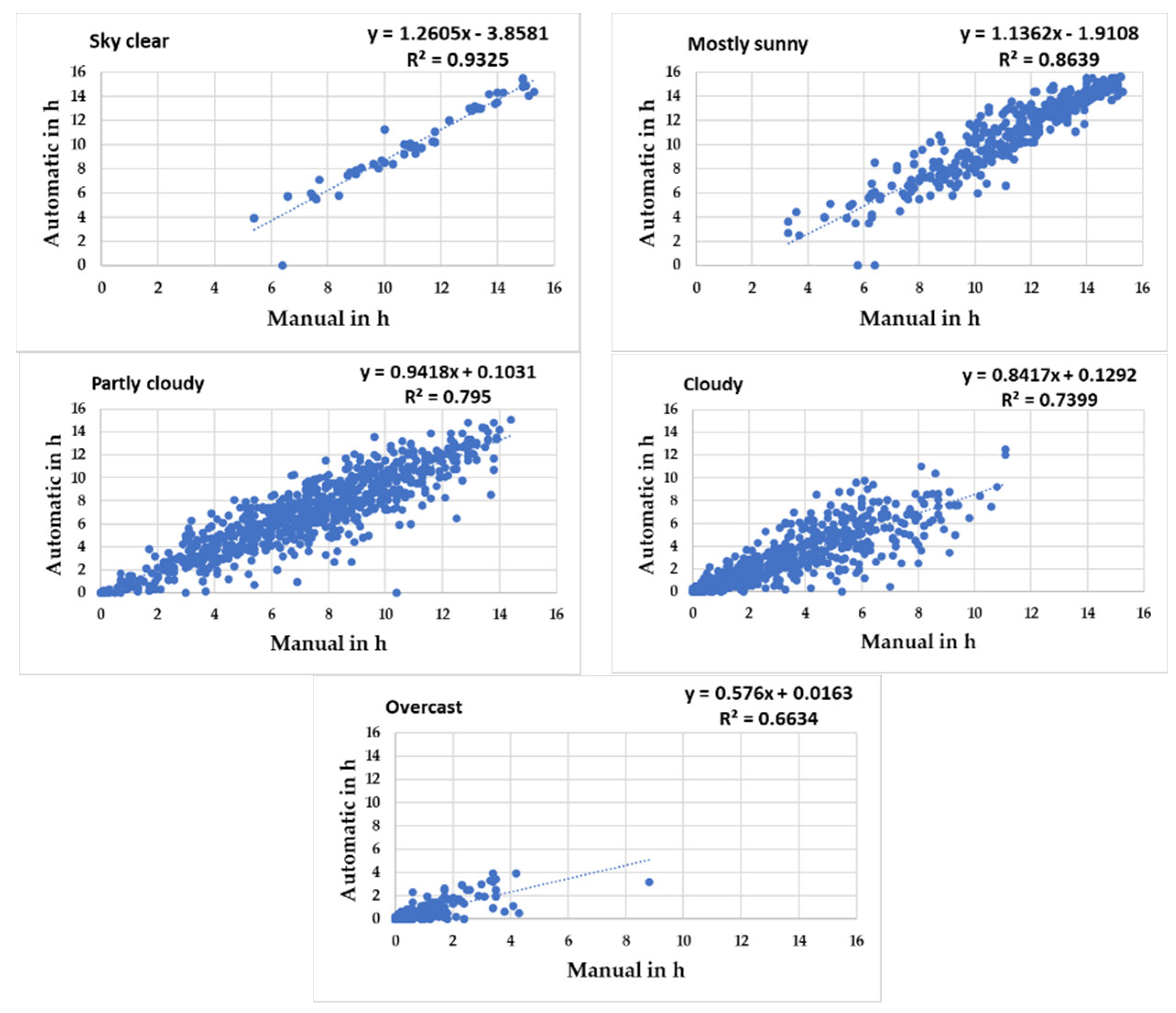
| Hours | I | II | III | IV | V | VI | VII | VIII | IX | X | XI | XII |
|---|---|---|---|---|---|---|---|---|---|---|---|---|
| ≥2.6 | 0.5 | 6.5 | 8.6 | 4.4 | 6.0 | 3.9 | 3.7 | 5.1 | 5.4 | 4.1 | 1.1 | 2.2 |
| [1.6:2.5] | 3.7 | 11.8 | 11.3 | 11.1 | 7.5 | 6.4 | 5.5 | 6.5 | 10.0 | 9.7 | 4.4 | 2.2 |
| [0.6:1.5] | 10.6 | 23.5 | 23.1 | 18.9 | 16.9 | 12.3 | 18.4 | 17.1 | 27.1 | 25.3 | 10.0 | 9.1 |
| [0.1:0.5] | 18.9 | 14.1 | 14.5 | 16.7 | 20.9 | 17.6 | 16.1 | 25.0 | 15.4 | 18.9 | 20.0 | 17.2 |
| 0.0 | 57.1 | 27.1 | 21.5 | 8.9 | 7.0 | 7.4 | 7.8 | 6.0 | 9.5 | 22.6 | 51.1 | 61.3 |
| [−0.1:−0.5] | 7.4 | 10.6 | 10.8 | 14.4 | 18.9 | 24.5 | 18.4 | 15.3 | 12.2 | 10.6 | 11.7 | 7.0 |
| [−0.6:−1.5] | 1.8 | 4.7 | 8.6 | 13.3 | 14.9 | 18.6 | 18.9 | 11.1 | 15.8 | 6.5 | 1.7 | 1.1 |
| −1.6:−2.5 | 0.0 | 1.8 | 1.6 | 8.3 | 6.0 | 6.9 | 8.8 | 10.6 | 3.6 | 2.3 | 0.0 | 0.0 |
| ≤−2.6 | 0.0 | 0.0 | 0.0 | 3.9 | 2.0 | 2.5 | 2.3 | 3.2 | 0.9 | 0.0 | 0.0 | 0.0 |
| Measurement | Average in h | Standard Deviation in h | Maximum in h | Skewness | Kurtosis |
|---|---|---|---|---|---|
| automatic | 5.0 | 4.5 | 15.3 | 0.48 | −1.03 |
| manual | 4.7 | 4.6 | 15.6 | 0.61 | −0.85 |
| Sunshine Duration | I | II | III | IV | V | VI | VII | VIII | IX | X | XI | XII | I–XII |
|---|---|---|---|---|---|---|---|---|---|---|---|---|---|
| CS in h | 29.1 | 68.5 | 107.1 | 204.1 | 263.4 | 256.4 | 224.2 | 237.8 | 163.9 | 89.6 | 31.9 | 21.3 | 1571.4 |
| CSD3 in h | 35.6 | 86.7 | 127.6 | 208.6 | 273.3 | 255.4 | 224.4 | 241.5 | 178.4 | 105.5 | 38.4 | 29.3 | 1804.7 |
| R = CSD3 − CS in h | 6.5 | 18.3 | 20.5 | 4.4 | 9.9 | −1.0 | 0.2 | 3.7 | 14.4 | 15.9 | 6.5 | 8.1 | 233.3 |
| CSD3 − CS in hours/day | 0.2 | 0.7 | 0.7 | 0.1 | 0.3 | 0.0 | 0.0 | 0.1 | 0.5 | 0.5 | 0.2 | 0.3 | 0.6 |
| R/CS in % | 22.3 | 26.7 | 19.2 | 2.2 | 3.8 | −0.4 | 0.1 | 1.6 | 8.8 | 17.8 | 20.4 | 38.0 | 14.8 |
| Month | Regression Equation | Determination Coefficient R2 |
|---|---|---|
| I | y = 1.1326x + 0.0850 | 0.9369 |
| II | y = 1.1073x + 0.3853 | 0.8882 |
| III | y = 1.0465x + 0.5011 | 0.8829 |
| IV | y = 0.9297x + 0.6261 | 0.8768 |
| V | y = 0.9209x + 0.8759 | 0.9091 |
| VI | y = 0.9062x + 0.7920 | 0.9345 |
| VII | y = 0.8951x + 0.7634 | 0.9026 |
| VIII | y = 0.8963x + 0.9144 | 0.8456 |
| IX | y = 0.9926x + 0.5221 | 0.8755 |
| X | y = 1.0942x + 0.2407 | 0.8969 |
| XI | y = 1.1084x + 0.1020 | 0.9057 |
| XII | y = 1.0916x + 0.1974 | 0.7630 |
| Category | N [octas] | n | Average CS [in h] | Average CSD [in h] | MD CSD − CS [in h] | RMSD [h] | r |
|---|---|---|---|---|---|---|---|
| clear sky | 0 | 52 | 10.3 | 11.2 | 0.9 | 1.4 | 0.9657 |
| mostly sunny | 0–2 | 374 | 11.0 | 11.4 | 0.4 | 1.3 | 0.9295 |
| partly cloudy | 3–5 | 765 | 6.9 | 7.2 | 0.3 | 1.6 | 0.8916 |
| cloudy | 6–7 | 638 | 2.7 | 3.1 | 0.4 | 1.4 | 0.8602 |
| overcast | 8 | 608 | 0.2 | 0.3 | 0.1 | 0.5 | 0.8145 |
| Hours | Clear | Mostly Sunny | Partly Cloudy | Cloudy | Overcast |
|---|---|---|---|---|---|
| ≥2.6 | 4.0 | 3.5 | 6.4 | 5.8 | 0.7 |
| [1.6:2.5] | 14.0 | 10.7 | 10.3 | 8.5 | 1.0 |
| [0.6:1.5] | 44.0 | 25.4 | 23.0 | 19.4 | 5.1 |
| [0.1:0.5] | 22.0 | 22.2 | 15.6 | 21.9 | 14.8 |
| 0.0 | 4.0 | 3.2 | 3.4 | 13.1 | 72.2 |
| [−0.1:−0.5] | 8.0 | 16.8 | 16.7 | 16.0 | 5.3 |
| [−0.6:−1.5] | 4.0 | 12.6 | 15.2 | 9.4 | 0.8 |
| −1.6:−2.5 | 0.0 | 5.1 | 7.6 | 3.8 | 0.2 |
| ≤−2.6 | 0.0 | 0.5 | 1.8 | 2.2 | 0.0 |
Disclaimer/Publisher’s Note: The statements, opinions and data contained in all publications are solely those of the individual author(s) and contributor(s) and not of MDPI and/or the editor(s). MDPI and/or the editor(s) disclaim responsibility for any injury to people or property resulting from any ideas, methods, instructions or products referred to in the content. |
© 2023 by the authors. Licensee MDPI, Basel, Switzerland. This article is an open access article distributed under the terms and conditions of the Creative Commons Attribution (CC BY) license (https://creativecommons.org/licenses/by/4.0/).
Share and Cite
Owczarek, M.; Malinowska, M. Manual and Automatic Measurements of Sunshine Duration in Cassubian Lakeland (Northern Poland). Atmosphere 2023, 14, 244. https://doi.org/10.3390/atmos14020244
Owczarek M, Malinowska M. Manual and Automatic Measurements of Sunshine Duration in Cassubian Lakeland (Northern Poland). Atmosphere. 2023; 14(2):244. https://doi.org/10.3390/atmos14020244
Chicago/Turabian StyleOwczarek, Małgorzata, and Mirosława Malinowska. 2023. "Manual and Automatic Measurements of Sunshine Duration in Cassubian Lakeland (Northern Poland)" Atmosphere 14, no. 2: 244. https://doi.org/10.3390/atmos14020244
APA StyleOwczarek, M., & Malinowska, M. (2023). Manual and Automatic Measurements of Sunshine Duration in Cassubian Lakeland (Northern Poland). Atmosphere, 14(2), 244. https://doi.org/10.3390/atmos14020244







